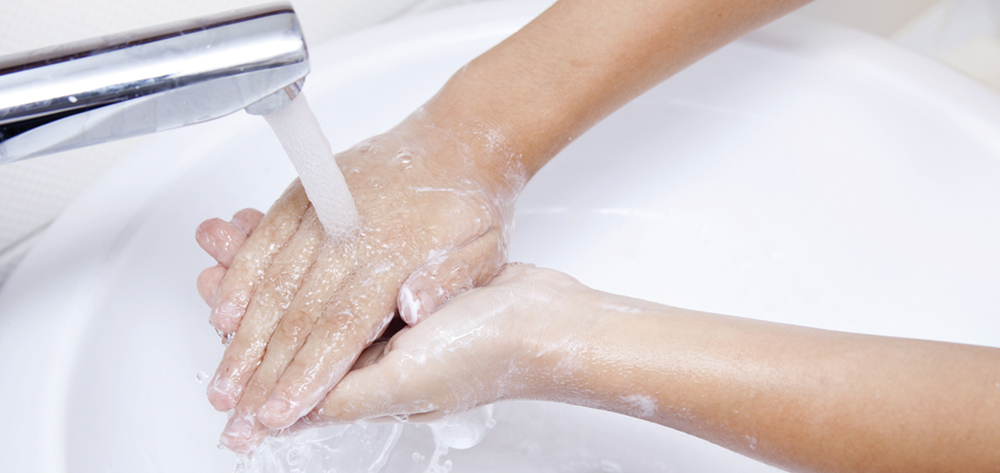For nearly two centuries, we’ve had evidence that hand hygiene reduces healthcare-associated infections. Yet many healthcare organizations still struggle to improve compliance with hand-hygiene guidelines. Like many other facilities, Dartmouth-Hitchcock Medical Center (DHMC) in Lebanon, New Hampshire has launched a series of hand-hygiene campaigns over the years. Although each one yielded some improvements, these weren’t sustained.
The Centers for Disease Control and Prevention, World Health Organization, and Association for Professionals in Infection Control and Epidemiology recommend multimodal hand-
hygiene improvement programs, because single strategies are unlikely to sustain improvements. Improvement strategies should focus on cultural change, leadership support, education and training, evaluation and feedback, multidisciplinary teams, readily accessible hand-hygiene products, workplace reminders, and monitoring of healthcare-
associated infections. Although much progress in hand-hygiene compliance has been made over the last few years, no off-the-shelf, one-size-fits-all improvement program exists.
“Hand Hygiene, A Contact Sport” is the slogan of our most recent campaign at DHMC. Called Team Care, it emphasizes the importance of performing hand hygiene before and after contact with every patient or with the patient environment. Team Care features the “Triple E” approach:
- Education—ensuring staff know why, how, and when to perform hand hygiene
- Environment—ensuring hand-hygiene products are available at the point of care
- Encouragement—creating a culture where everyone feels enabled to give a friendly reminder to a colleague who’s about to miss a hand-hygiene opportunity. This aspect of the campaign hinges on the concept that sustained improvement comes only by creating a culture where everyone is invested in patient safety.
How Team Care began
At DHMC, each inpatient unit is responsible for initiating hourly purposeful rounding, interdisciplinary rounding, leadership rounding, and nurse knowledge exchange at the bedside. Units receive a toolkit on minimal expectations for each initiative, which they can tailor to their own unit. Then they share success stories with each other at quarterly meetings. Even though ideas may spread from unit to unit, they’re customized to meet each unit’s needs.
In 2014, DHMC created the Team Care concept at a safety summit to address healthcare-
acquired conditions, such as falls, catheter-associated urinary tract infections, and central line–associated bloodstream infections. We decided Team Care was the perfect platform from which to launch our hand-hygiene campaign.
Electronic hand-hygiene monitoring
Electronic monitoring systems, which monitor hand-hygiene events 24/7, have great potential. At DHMC, we’ve been trialing an electronic hand-hygiene monitoring system in two units since February 2015. Although the system provides invaluable data, it entails significant work. For instance, staff members must wear a badge that tracks their movements on the unit. They must wear the badge on a visible location on their chest, because the system may record compliance inaccurately if employees keep it in their pocket or cover it with a lab coat. Also, low batteries in the badges or monitors can affect recording.
The manufacturer’s representative and facility staff can help identify and troubleshoot problems to ensure the software works properly. Although maintaining and troubleshooting the system can take time, it’s far faster than performing direct observations. Also, the data aren’t subject to many of the other limitations inherent to direct observation, such as a small, nonrepresentative sample size, inter-observer variation, and the Hawthorne effect.
All components needed for a successful hand-hygiene campaign still apply when using an electronic monitoring system—leadership, culture change, education and training, product accessibility, and workplace reminders. Based on our experience at DHMC, change management, unit culture, and local leadership can significantly affect campaign success.
Unit variations
During our trial, we quickly saw a dramatic improvement in hand hygiene on a unit we’ll call Unit A. Based on manufacturer recommendations, unit leaders started posting their top 10 performers. Staff received this well, even competing to see who could achieve the best hand-hygiene compliance.
Unit B, the other unit that tested the software, also posted its top performers. But unlike Unit A, a competitive strategy didn’t motivate all staff members; in fact, it upset some. After some trial and error, the unit eventually achieved success. We believe that success stemmed largely from an automatic report e-mailed to Unit B staff members each morning that showed their individual compliance rate for the previous day. (Unit A chose not to have compliance reports automatically e-mailed each morning.)
Successful trial
Based on our goal of 100% hand-hygiene compliance before and after every patient encounter, we consider our trial with electronic monitoring a success. During the baseline period, registered nurses’ in-and-out of the room compliance averaged 50%. (Initially, we found this low rate shocking because direct observation from our infection prevention team typically showed average compliance for nurses exceeding 90%.) As of September 2015, the average compliance for nursing exceeded 80%.
We believe the electronic monitoring system shows great promise in helping us sustain hand-hygiene improvements. Past DHMC campaigns have lost momentum as staff struggled to continue collecting hand-hygiene data through direct observation. In contrast, the electronic system collects enormous amounts of data continually and distributes them to leadership throughout the hospital. With adoption of this software, we believe we will finally sustain improvements in compliance.
We’ve found that locally owned and driven changes are more likely to succeed. We’ve seen this both with hand-hygiene priorities and process improvement work. At times, we may feel as though we’re reinventing the wheel, but the additional effort pays off when we see sustainable improvements.
Frontline ownership: The key to success
Association for Professionals in Infection Control and Epidemiology (APIC). APIC Implementation Guide: Guide to Hand Hygiene Programs for Infection Prevention. 2015. apic.org/For-Media/Announcements/Article?id=b56a685f-7ee9-4206-a861-0659fbf848a1
Boyce JM, Pittet D; Healthcare Infection Control Practices Advisory Committee; HICPAC/SHEA/APIC/IDSA Hand Hygiene Task Force. Guideline for Hand Hygiene in Health-Care Settings. Recommendations of the Healthcare Infection Control Practices Advisory Committee and the HICPAC/SHEA/APIC/IDSA Hand Hygiene Task Force. Society for Healthcare Epidemiology of America/Association for Professionals in Infection Control/Infectious Diseases Society of America. MMWR Recomm Rep. 2002;51(RR-16):1-45. cdc.gov/mmwr/PDF/rr/rr5116.pdf
Gardam M, Gitterman L. If you don’t succeed the first 20 times, please try something different. Qmentum Q. 2013;6(2):6-11. accreditation.ca/sites/default/files/qq-fall-2013.pdf
Kirkland KB, Homa KA, Lasky RA, Ptak JA, Taylor EA, Splaine ME. Impact of a hospital-wide hand hygiene initiative on healthcare-associated infections: results of an interrupted time series. BMJ Qual Saf. 2012;21(12);1019-26.
World Health Organization (WHO). WHO Guidelines on Hand Hygiene in Health Care: a Summary. 2009. who.int/gpsc/5may/tools/who_guidelines-handhygiene_summary.pdf
The authors work in the Quality Assurance and Safety department at Dartmouth-Hitchcock Medical Center in Lebanon, New Hampshire. Megan Read is an infection preventionist. Karen Chandler is a senior clinical quality specialist.


















